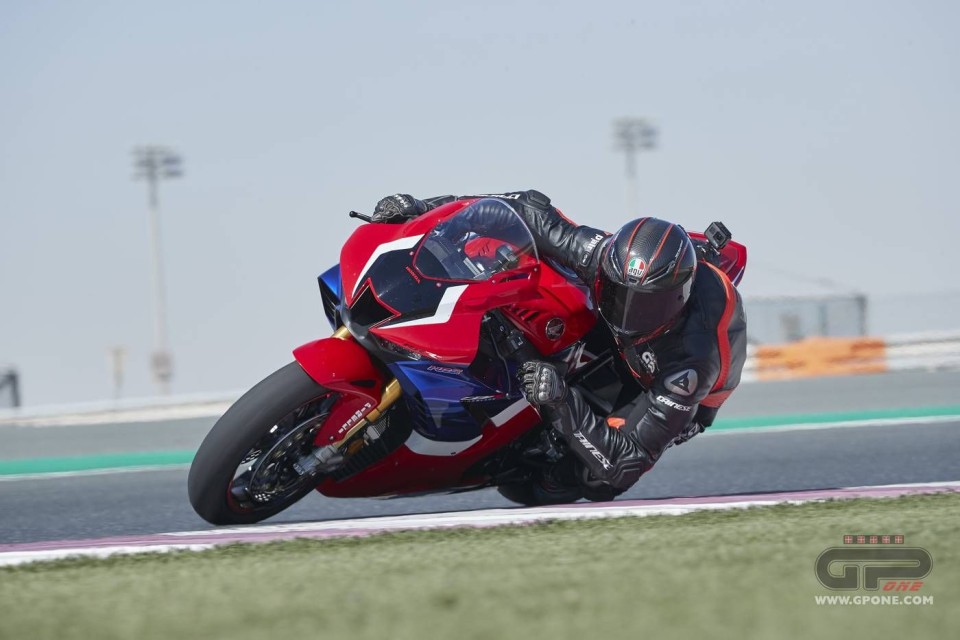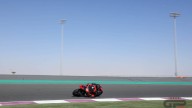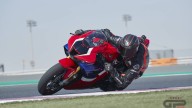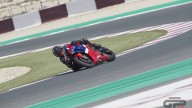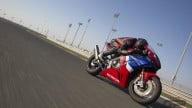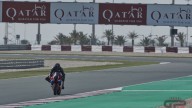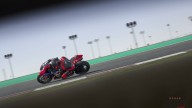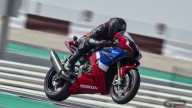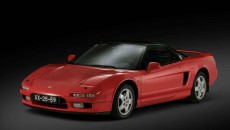by Luca Bono
Qatar: At the fast Losail circuit we have been putting the new CBR 1000 RR-R through its paces. Before expressing a judgment on the new bike, we waited for the end of the fourth test session, there are many things to verify on the bike and it's complicated; moreover, the Losail track is not among the easiest, with few points of reference and many curves to learn that close up "late".
After reading the data, not only power but also technical characteristics, we expected a motorcycle that had an extreme riding style, close to the most powerful Aprilias, BMWs and Ducatis. But all we had to do was to remember the history of Honda sport bikes, which have never betrayed their characteristic DNA, to realize that even this record-breaking CBR1000RR-R would have been easy, user-friendly and soft in all areas of riding - during turn-in, when braking, cornering, accelerating - and with predictable reactions. On balance (with the stopwatch), however, it allows you to go very fast: and this is the aim of the designers.
299 KM/H IN FOURTH!
This aspect of its character generates a little less adrenaline, also thanks to the engine with less torque than the competitors and a very relaxed final gear that penalizes the new CBR in low speed starts. Then the four-cylinder inline engine pushes hard: in fourth at the limiter the speedometer on the straight indicates over 299 km/h (GPS 292 km/h!). Then when you hit fifth gear, you easily break through the 300 km/h barrier. It wouldn't surprise us if the new CBR 1000 becomes the fastest bike in its class!
It is a four-cylinder in-line that wants to rev high: it revs roundly low down, going by the Honda handbook, up to 8000-9000 rpm it pushes regularly, but without emphasis, then the best comes, with an overwhelming extension up to 14,500 rpm: let's not forget that we are over 217.5 hp, the benchmark to date for a 1000cc super sport bike. The engine is a four-cylinder and compact configuration with a short stroke, with the bore/stroke of Marc Marquez's RC213V and anti-friction technologies of the RC213V-S, equipped with a mixed chain-gear distribution. The values are the same 81 x 48.5 mm as the RC213V-S, a radical change compared to the 76 x 55.1 mm of the previous Fireblade.
To achieve this performance, Honda technicians worked on every detail, from the new mixed chain-gear distribution system to the DLC (Diamond Like Carbon) coating on the cam lobes, just like on the RC213V-S. It is the first time that this process has been used on a mass-produced motorcycle and it results in a 35% reduction in friction loss. Finger rockers, titanium connecting rods and forged aluminium pistons also reduce inertial weight.
To make the new engine breathe better, the intake air is channelled to the airbox through a duct located on the windshield at the point of greatest aerodynamic pressure (+25%). The dimensions of the opening are equivalent to those of the RC213V MotoGP bike.
The gentle delivery and long ratios, however, can be deceptive and don’t strain the engine or dilute the effect of speed, but in fact it goes a long way, and at this track we exceeded the actual 300 km/h of GPS.
The response of the Ride by Wire goes accordingly: if you open the throttle at medium revs the response is not instantaneous, and to have a better connection with the rear tyre you have to go over 11,000; with the engine more willing, peak torque is even further along the line, 113 Nm at 12,500 rpm. At these revs, there is truly a lot of power, and by keeping the throttle open, especially in the faster corners, you can keep to the apex thanks also to the help of slight rear-end drift. In extreme cases, you can feel that the motorcycle brushes to the side while maintaining a perfect set-up, with great chemistry between the front and the rear and travelling a long way, an ace up the sleeve of the CBR100RR-R.
The ratios are spaced on a regular basis, a valuable choice that makes it more comfortable in everyday use, but the very long first gear, a classic of the most extreme racers, would have allowed the remaining gears to be brought closer together, thus promoting efficiency on the track.
This good character is not surprising if you have the Honda philosophy in mind, and then the limitations of Euro 5 must also be considered. The exhaust valve, for example, developed with Akrapovic, opens towards 5,000 rpm, and together with the mapping made to respect the limits it penalizes low-range delivery. Then there is also the architecture, an in-line four is naturally softer at mid-low range and more progressive towards the highs compared to a V4.
DOWN IN THE FAIRING!
You exit in second gear from the final corner towards the pit straight, third, fourth at the finish line, fifth at over 300km/h, brake after 200 meters. When you brake really hard, ABS tends to kick in - you feel it, as always, from the pulsing of the lever and the sensation of slightly lengthening your braking.
Even the response of the braking system is in line with the character of the CBR1000RR-R: the onset is soft and does not give the impression of immediately biting too hard but then, when pulling on the lever, it turns out that the power is not lacking thanks to the Brembo Stylema (only on the SP) calipers and now 330mm discs. After the numerous braking sections at top speed, the control tends to "soften" and the response, while not becoming spongy, loses part of the feeling that it had when the system was cooler.
The feeling at the entrance to the corner with the 220mm rear is excellent, allowing the rear end to ‘brush’ naturally. Only the height of the lever from low down is slightly to be revised. It is difficult to operate when you are at maximum lean to the left to correct the line.
STABLE AT BIRTH EVEN WITHOUT WINGS
To generate downforce at high speeds and keep the front area of the fairing as small as possible, the CBR1000RR-R uses side winglets with the same structure as those used on the 2018 RC213V MotoGP. This results in a reduction of wheelie in acceleration and a greater stability during braking and when cornering. On the CBR1000 RR-R it didn’t seem decisive, that is, they don’t help to eliminate nervousness and bumping: talking to the technicians we learned that at high speeds they manage to generate a downforce of about ten kilos, useful but certainly difficult to feel. They also pointed out that this arrangement (deep vertically and slightly extended longitudinally) has no negative effect on the yaw and roll capacity when entering corners, compared to solutions that expand longitudinally such as those mounted by Aprilia and Ducati.
We can therefore say that the CBR1000RR-R is very precise and stable in design, and this thanks also to the wheelbase (1,455mm + 50mm compared to the 2019 CBR-RR) and the longer swingarm (+ 30.5mm), the latter taken from the RC213V-S (MotoGP road replica).
Wing effect apart, the aerodynamics are perfect, the windshield is low, but the lower tank of 40 mm helps a lot to be completely protected anyway, like being in an air bubble that embraces the torso, legs, arms and feet , a great advantage in races where this effect ensures comfort, therefore a less tiring ride. The aerodynamics are studied down to the last detail, the lateral openings of the front fairing ensure agility at high speeds, the side fairing protects the legs and feet very well and deflects the flow of air that "hits" the rear wheel. Finally, the rear fender is designed to discharge the air and avoid the slightest load-bearing effect. All this translates into a record air resistance CX value of 0.27!
Excellent riding position, decidedly racing, with high footrests (+ 21mm), lower handlebars (-17mm) and 10mm higher seat, now 830mm.
The fuel tank is a little too large and in braking, it is difficult to squeeze it with your legs. It needs to be slightly more hollowed out so as to anchor better with your knees.
When you are tucked in the fairing, the main information of the dashboard, speed and lap time, is easily readable otherwise the numbers are very small.
IN THIS WAY IT BECOMES MORE REACTIVE AND PRECISE
In track riding the CBR1000RR-R is stable even in the standard suspension adjustment (43 mm Öhlins NPX inverted fork, with S-EC system - Semi active Electronic Control - and Öhlins TTX36 shock absorber always with S-EC system) that we found rather soft. To find more responsiveness and improve the effectiveness of riding on the track, we hardened them by increasing compression, discovering that they are very sensitive to adjustments. The CBR1000RR-R thus becomes more reactive and thanks to a lower load transfer, it is more sustained in corner turn-in with the brakes pinched and faster in changes of direction.
UNBEATABLE IN KEEPING THE LINE
Even with less unrestrained suspension, the fork remains soft, a design choice to enhance the closure of the trajectories. Pushing hard, in fact, and entering the curve with the brakes pulled, you feel that the front end floats slightly: in this situation, don’t worry, you must trust and let the bike do it for you, by simply closing the throttle the CBR1000RR-R immediately keeps the line, and when you reopen you are in the perfect position to raise the bike and download all the horsepower on the straight. Going close to the edge with the CBR1000RR-R is very natural, thanks to the chassis design, the effectiveness of the engine braking and the speed of the electronic gearshift when downshifting, truly amazing for the softness and precision of the clutch even in the most demanding downshifts from 5th in 1st gear, without any hesitation.
DANCING WITH A CLOSED THROTTLE
This track allowed us to fully test the chassis of the CBR1000RR-R, because it is very technical and puts it severely to the test. There are curves where you enter very fast with the throttle closed, then you need to go wide and connect, always with the throttle closed, to exit with the motorbike up again and then open wide on the straight, a dance that you can hardly perform if the chassis does not leave ample room for manoeuvre.
Regarding what has been said about the delivery curve, at the exit of the slower corners you would like more torque, but this should be combined with traction control from racing. The six-axis inertial platform (IMU) (five in the CBR 2019) accurately monitors the dynamics of the motorcycle in 3D and provides input to all the riding electronics: pitch, yaw and roll including the new Showa HESD electronic piston steering damper. The operation of the first phase, with the bike leaning over considerably, is not bad even if on some occasions there was a little bit too much loss of grip. It should be followed by a second part that is more progressive, one that allows you to slide the tyre just enough to optimize acceleration. Now, if you leave it intrusive, it cuts too much power; on the contrary, set to the minimum, it is too free and does not convey the immediate trust that one would expect. It requires more progression and more fluidity to bring the bike back online.
Level 2 anti-wheeling is more for the road, it cuts decisively as soon as the control unit reads the detachment of the front wheel from the ground; on position 1 the effect is suitable for the track but functionality is not yet at the level of its rivals (Aprilia), the one that allows you to make your own way with the front end that floats an inch from the ground.
KEYLESS
The new CBR1000RR-R Fireblade adopts the Honda Smart Key system. The start works without having to insert any key, as well as the steering lock. It is also a convenient option for road use and has allowed the use of a "clean" racing style upper steering plate, while freeing up space for the air intake system.
ONBOARD COMPUTER
For a complete and user-friendly control of the CBR1000RR-R systems, the 5” colour TFT display is larger and with a higher resolution. It is fully customizable to show exactly what the rider wants to see. We found it truly rich in information, but difficult to read in some configurations.
INFINITE GRIP: PIRELLI SC1
A final round of applause goes to the tyres that have allowed the CBR-RR-R to express itself to the full and unload all of its 217.5 hp onto the ground. We used the Pirelli SC1 compound in the sizes 120/70 front and in the maxi 200/60 rear, the same as the ones used in the FIM Superbike World Championship, a race replica tire.
What surprised us is not only the grip, which can be said to be infinite, but also the ease with which you can unload all the horsepower onto the ground with maximum safety. In starts at Losail, you leave long black stripes on the tarmac. Then there is what has always been the strong point of Pirelli: braking. The feeling is excellent not only when you go from 300 to 100km/h with an upright bike (turn 1), but in particular when you enter a curve pinching the brakes, you have the maximum feeling of support, without any self-righting effect. In Losail there are many curves that undermine the tyres with a true SBK lean angle of around 60°!
CBR 1000 RR-R FIREBLADE SP
The model we tested is the SP version, which mounts Öhlins suspensions in place of the traditional Showa, standard quickshifter and Brembo calipers that are more powerful than the Nissin calipers mounted on the basic version. In addition, weight is also saved thanks to a lighter lithium battery.
RACING BUT… ALSO IN THE PRICE!
Performance increases, but so does the price. To buy the new CBR 1000 RR-R you need a larger wallet than the previous model: € 22,990 for the base model and € 26,990 for the SP version.
Technical Specifications CBR1000RR-R FIREBLADE 2020
|
ENGINE |
|
|
Type |
water-cooled, 4-stroke, DOHC, inline,4-cylinder, Euro 5 |
|
Displacement |
999.9 cc |
|
Distribution |
Mixed chain-gears |
|
Bore x stroke |
81 x 48.5 mm |
|
Compression ratio |
13.0: 1 |
|
Max. Power Output |
217.5 hp @ 14,500 rpm |
|
Max. Torque |
113Nm @ 12,500 rpm |
|
Oil Capacity |
4 L |
|
FUEL FEED |
|
|
Carburation |
PGM-DSFI electronic ignition |
|
Fuel Tank |
16.1 litres |
|
Consumption |
16 km/l (average cycle WMTC) |
|
ELECTRICS |
|
|
Starter |
Electric |
|
Battery Capacity |
12-6 YTZ7S |
|
TRANSMISSION |
|
|
Clutch |
Wet, multiplate, hydraulic |
|
Gearbox |
6-speed |
|
Final Drive |
Chain |
|
CHASSIS |
|
|
Type |
Twin-spar in composite aluminium |
|
DIMENSIONS AND WEIGHTS |
|
|
Dimensions (L x W x H) |
2100 x 745 x 1140 mm |
|
Wheelbase |
1455 mm |
|
Caster Angle |
24o |
|
Trail |
102 mm |
|
Seat Height |
830 mm |
|
Ground Clearance |
115 mm |
|
Kerb Weight |
201 kg |
|
SUSPENSION |
|
|
Front |
Ohlins NPX S-EC 43mm telescopic fork |
|
Rear |
Ohlins TTX36 S-EC Pro-Link swingarm |
|
WHEELS |
|
|
Front |
17” x 3.50 |
|
Rear |
17” x 6.00 |
|
TYRES |
|
|
Front |
120/70-ZR17 Pirelli Diablo Supercorsa SP Bridgestone RS11 |
|
Rear |
200/55-ZR17 Pirelli Diablo Supercorsa SP Bridgestone RS11 |
|
Brakes |
|
|
ABS type |
2 channel with IMU |
|
Front |
330mm disc with radial-mount Brembo 4-piston caliper |
|
Rear |
220mm disc with Brembo 2-Piston caliper |
|
INSTRUMENTS AND ELECTRICS |
|
|
Instruments |
TFT-LCD |
|
Security |
HISS with Smart-Key |
|
Lights |
Full-LED |



